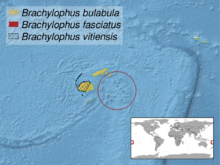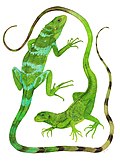| Brachylophus | |
|---|---|

| |
| Fiji banded iguana (Brachylophus bulabula) in captivity | |
| Scientific classification | |
| Domain: | Eukaryota |
| Kingdom: | Animalia |
| Phylum: | Chordata |
| Class: | Reptilia |
| Order: | Squamata |
| Suborder: | Iguania |
| Family: | Iguanidae |
| Genus: | Brachylophus Cuvier, 1829 |
| Type species | |
| Brachylophus fasciatus Cuvier, 1829 | |
| Species | |
|
Brachylophus bulabula | |

| |
The genus Brachylophus consists of four extant iguanid species native to the islands of Fiji and a giant extinct species from Tonga in the South West Pacific. One of the extant species, B. fasciatus, is also present on Tonga, where it has apparently been introduced by humans.
Etymology and taxonomy
The name, Brachylophus, is derived from two Greek words: brachys (βραχύς) meaning "short" and lophos (λόφος) meaning "crest" or "plume", denoting the short spiny crests found along the backs of these species.
Brachylophus species are the most geographically isolated iguanas in the world. Their closest extant relatives (the genera Amblyrhynchus, Conolophus, Ctenosaura, Cyclura, Iguana and Sauromalus) are present in primarily tropical regions of the Americas and islands in the Galápagos and Lesser and Greater Antilles. Several of these genera are adapted to xeric biomes. Phylogenetic evidence supports the Brachylophus lineage to have diverged from the rest of Iguanidae in the latest Eocene, about 35 million years ago. They are the second most basal extant genus in the family, with only Dipsosaurus diverging earlier. The location of members of Brachylophus, so distant from all other known extant or extinct iguanids, has long presented a biogeographical enigma.
One hypothesis to account for this biogeographical puzzle, based in part on an estimated divergence date of 50 million years ago (although more recent studies have revised this to about 35 million years ago), is that these species are the descendants of a more widespread but now extinct lineage of Old World iguanids that migrated overland from the New World to Asia or Australia, and then dispersed by some combination of continental drift, rafting and/or land bridges to their present remote location. However, no other fossil or extant species of this putative lineage have been found to date in Southeast Asia, Australasia or the western Pacific outside of Fiji and Tonga.
A secondary hypothesis, and the more widely accepted one, is that these species evolved from New World iguanas that rafted 10,000 km (6,200 mi) west across the Pacific Ocean with the aid of the South Equatorial Current. While a rafting voyage of four months or more might seem implausible, the ancestors of Brachylophus may have been preadapted for such a journey by having water requirements that can be satisfied by food alone, as well as comparatively long egg incubation periods.
Extant species
The extant species are:
| Image | Scientific name | Common Name | Distribution |
|---|---|---|---|
 |
Brachylophus bulabula | Central Fijian banded iguana | Northwestern islands of Fiji (Ovalau, Kadavu and Viti Levu) |
 |
Brachylophus fasciatus | Lau banded iguana | Eastern Fijian islands |
 |
Brachylophus gau | Gau iguana | Gau island |
 |
Brachylophus vitiensis | Fiji crested iguana | Northwestern islands of the Fijiian archipelago |
Historically, only the first two were recognized, but B. bulabula ("bulabula" is the Fijian word for "healthy" or "flourishing") was described in the central regions of Fiji by a team led by a scientist from the Australian National University in 2008. Detailed genetic and morphological analyses were made to conclude that B. bulabula represents a third species. In 2017, B. gau was described as a new species from Gau Island.
A giant Tongan species, Brachylophus gibbonsi, similar in size and build to an iguana of the genus Cyclura once existed on Lifuka, islands in the Ha‘apai group and Tongatapu but became extinct in prehistoric times due to predation by humans and their domestic animals. An even larger extinct iguana of the separate genus Lapitiguana was formerly present on Fiji.
References
- ^ Fisher, R. N.; Niukula, J.; Watling, D.; Harlow, P. S. (2017). "A New Species of Iguana Brachylophus Cuvier 1829 (Sauria: Iguania: Iguanidae) from Gau Island, Fiji Islands". Zootaxa. 4273 (3): 407–422. doi:10.11646/zootaxa.4273.3.5. PMID 28610241. Retrieved 2018-08-14.
- ^ Keogh, J. Scott; Edwards, Danielle L.; Fisher, Robert N.; Harlow, Peter S. (2008-10-27). "Molecular and morphological analysis of the critically endangered Fijian iguanas reveals cryptic diversity and a complex biogeographic history". Philosophical Transactions of the Royal Society B: Biological Sciences. 363 (1508): 3413–3426. doi:10.1098/rstb.2008.0120. PMC 2607380. PMID 18782726.
- ^ Malone, Catherine L.; Reynoso, Víctor Hugo; Buckley, Larry (2017-10-01). "Never judge an iguana by its spines: Systematics of the Yucatan spiny tailed iguana, Ctenosaura defensor (Cope, 1866)". Molecular Phylogenetics and Evolution. 115: 27–39. Bibcode:2017MolPE.115...27M. doi:10.1016/j.ympev.2017.07.010. ISSN 1055-7903. PMID 28716742.
- ^ Noonan, B. P.; Sites, J. W. Jr. (2009-11-24). "Tracing the origins of iguanid lizards and boine snakes of the Pacific". The American Naturalist. 175 (1): 61–72. doi:10.1086/648607. PMID 19929634. S2CID 5882832.
- Cogger, Harold (1974). "Voyage of the Banded Iguana". Australia Natural History. 18 (4): 144–149.
- ^ Gibbons, J. R. H. (1981-07-31). "The biogeography of Brachylophus (Iguanidae) including the description of a new species, B. vitiensis, from Fiji". Journal of Herpetology. 15 (3): 255–273. doi:10.2307/1563429. JSTOR 1563429.
- Brachylophus at the Reptarium.cz Reptile Database. Accessed 23 March 2017.
- Cooper, Dani (2008-09-16). "Hello, it's a new species of Pacific iguana". ABC Science. Australian Broadcasting Corporation. Retrieved 2010-09-28.
- "Scientists Discover New Species of Fijian Iguana". USGS. 6 June 2017. Retrieved 9 June 2017.
- Pregill, Gregory K.; Dye, Tom (1989). "Prehistoric extinction of giant iguanas in Tonga". Copeia. 1989 (2): 505–508. doi:10.2307/1445455. JSTOR 1445455.
- Pregill, G. K.; Steadman, D. W. (March 2004). "South Pacific iguanas: Human impacts and a new species". Journal of Herpetology. 38 (1): 15–21. doi:10.1670/73-03A. JSTOR 1566081. S2CID 85627049.
- Pregill, G. K.; Worthy, T. H. (March 2003). "A new iguanid lizard (Squamata, Iguanidae) from the Late Quaternary of Fiji, Southwest Pacific". Herpetologica. 59 (1): 57–67. doi:10.1655/0018-0831(2003)059[0057:ANILSI]2.0.CO;2. S2CID 85804786. Archived from the original on 2022-04-27. Retrieved 2017-12-13.
- Frost, D.E. & Etheridge, R.E. (1989) A Phylogenetic Analysis and Taxonomy of Iguanian Lizards (Reptilia: Squamata). University of Kansas Museum of Natural History Miscellaneous Publications 81: 1-65. doi:10.5962/bhl.title.16288 PDF fulltext
- Frost, D.R.; Etheridge, R.E.; Janies, D. & Titus, T.A. (2001): Total evidence, sequence alignment, evolution of Polychrotid lizards, and a reclassification of the Iguania (Squamata: Iguania). American Museum Novitates 3343: 1-38. PDF fulltext
External links
| Iguanidae | ||||||||||||||||||||||||
|---|---|---|---|---|---|---|---|---|---|---|---|---|---|---|---|---|---|---|---|---|---|---|---|---|
| ||||||||||||||||||||||||
| Taxon identifiers | |
|---|---|
| Brachylophus | |